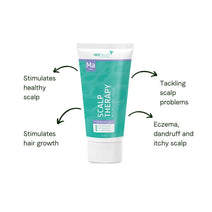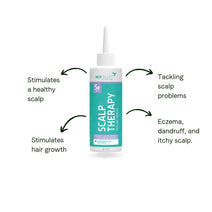What to do about scabs on your scalp?
What are scabs on the scalp?
Scalp scabs are actually nothing more than pieces of skin that are much drier than the surrounding skin. They feel hard and rough and can vary in size and colour. Scabs can be white, yellow or red, depending on various factors such as the cause and age of the scab.
White scabs on your scalp
These may result from psoriasis, a condition characterised by intense itching. The scales of psoriasis often have a silvery colour, distinguishing them from other scabs. Scalp psoriasis is a common cause of white scabs and is characterized by thick, crusty plaques that can appear silver-gray or gray.
Yellow scabs on scalp
These scabs on the head appear for various reasons. They may be due to sebum secretion from the skin or an infection. They also sometimes arise due to breakdown and washing away of haemoglobin from red blood cells in the crust.
A fungal infection can cause yellow scabs, often accompanied by symptoms such as itching and a red rash.
Red scabs on head
Red scabs are usually caused by an allergic reaction to irritants, dry and dead skin, or other skin conditions. During the healing process, these scabs may become darker, although in some people, the scab actually lightens over time and even loses its colour. Scalp sores can also cause red scabs and may result from various medical conditions such as chicken pox, shingles, and lupus.
Why do scabs form on your scalp?
Crusts on the scalp can have several causes, ranging from skin conditions to external factors.
Head lice are a common cause of scabs on the scalp. These tiny, parasitic insects are highly contagious and can lead to intense itching and irritation. Scratching the affected areas can result in scabs and even infections. Over-the-counter (OTC) treatments are available to effectively eliminate head lice and prevent their spread.
Scaly patches on the scalp can also lead to the formation of scabs. These patches may be a symptom of fungal infections like ringworm or skin disorders such as psoriasis and lupus. Identifying the underlying cause is crucial for appropriate treatment, which may include antifungal medications or topical treatments for skin disorders.
Advice personalized to your hair needs
Take our Hairtest to find the best products for your hair within 2 minutes!
Crusts on the scalp due to Psoriasis
Psoriasis on your scalp is a chronic condition that can cause scabs that are difficult to heal. This condition leads to the rapid reproduction of skin cells, resulting in thick, crusty patches. These crusts are often silver- or greyish in colour and can spread all over the forehead and even appear on the back of the head. Salicylic acid is effective in treating psoriasis by removing excess skin cells, easing symptoms, and managing itching.
Crusts on the head due to contact dermatitis
Contact dermatitis, a common cause of dry scabs, occurs when the skin comes into contact with irritants such as certain shampoos or soaps. Using the right shampoo for scabs on the scalp can help reduce itching and dryness. Additionally, using a medicated shampoo can help treat contact dermatitis by reducing itching and inflammation.
Crusts on the scalp due to stress
Prolonged and intense stress can lead to infections on the scalp. Even if the scalp is in good condition at the time, stress can make you feel itchy on the head. This makes you prone to scratching, which can cause wounds and scabs. Untreated scalp conditions caused by stress can lead to permanent hair loss.
Crusts on scalp due to dandruff or seborrheic dermatitis
Dandruff, or seborrheic dermatitis, is another common cause of scabs on the scalp. These scabs can be yellowish or white and are often caused by itching and scaly skin. Effective treatment with a scalp treatment for scabs can help to exfoliate and soothe the scalp. Medicated shampoos containing specific active ingredients like anti-fungal agents and salicylic acid can help treat dandruff and seborrheic dermatitis.
Scratching at scabs on your scalp because of itching, can cause hair loss. Repeatedly damaging hair follicles by scratching can worsen hair loss and may even lead to infections that can further exacerbate itching and hair loss. It is therefore important to address the cause of the scabs and avoid scratching your scalp to prevent further complications.
What are the crusty spots on my scalp?
Seborrheic dermatitis is a common, noncontagious and easily-managed skin condition. It can cause rash on your face and white to dark spots on your skin. Scalp ringworm is a fungal infection that can cause crusty spots on the scalp.
Treating scabs on the scalp
Luckily, there are solutions to treat scabs on the scalp. One effective treatment is to use the scalp therapy line from Neofollics, designed to treat scabs in three easy steps:
-
Peeling serum: This serum loosens scabs and scalps, making them easier to remove. It also improves the overall health of the scalp and provides a good foundation for healthy hair growth.
-
Exfoliating shampoo: The shampoo contains a scrub that helps remove crusts and flakes from the head. It is a shampoo with conditioning ingredients specifically designed to provide relief to the scalp.
-
Nourishing mask: This mask conditions the scalp, making it healthier and reducing the risk of new scabs.
By following these three steps, you can not only get rid of existing scabs, but also improve the health of your scalp and prevent new scabs from forming.
Conclusion
Crusts on the scalp can be quite annoying and have different causes and treatments. From psoriasis to contact dermatitis and even stress, there are several causes involved. Fortunately, there are effective hair and scalp care products that can treat scabs and improve the overall health of the scalp. It is important to address these scabs and prevent scratching, not only for relief, but also to prevent hair loss and other scalp complications.
In some cases, a skin biopsy may be necessary to diagnose serious scalp conditions. Persistent lesions on the scalp may indicate skin cancer and should be monitored.















